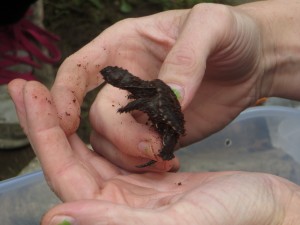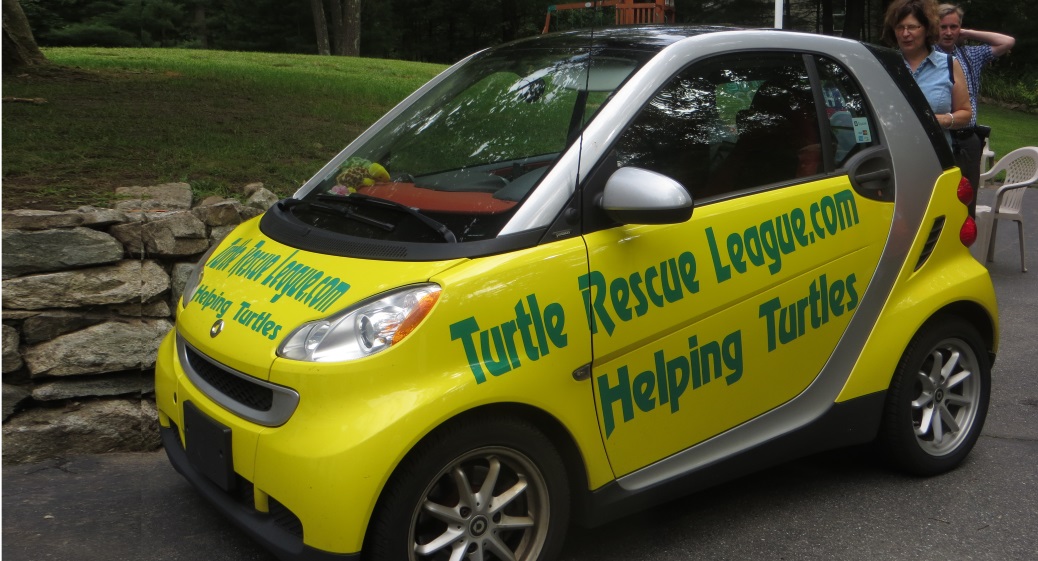Water Closet for September 5, 2014
On June 8th Kristen Thompson of North Andover witnessed a hit-and-run accident on Essex Street in Middleton. She stopped her car and ran to the victim, a female snapping turtle. Nearby on the asphalt were eggs that had oozed from mother on impact. Mrs. Turtle must have been en route to egg-laying ground. Kris carefully picked up eggs and injured mother who still showed signs of life. [pullquote]”it requires one female to lay 3000 eggs in her lifetime (which can be 50 years or more ) to assure one adult reaches maturity”[/pullquote]She then called around for help and finally got the Turtle Rescue League out of Southbridge.1 A member came and extracted more eggs from mother so all together 38 eggs were placed in a league incubator.

This car’s drivers are careful not to run over turtles. We all should be.
– Judy Parrot-Willis photo
That was two and one-half months ago, snapping turtle eggs’ summer incubation time. On Saturday, August 23, Kris invited all involved in the rescue saga and more to her home for a hatchling release party.
Soon after the accident Kris had called Middleton’s Conservation agent. The agent contacted an old Stream Teamer interested in turtles. The Stream Teamer, unable to attend the party, asked Kris if Judy Parrot-Willis, a fellow North Andoverite, an enthusiastic amateur wildlife photographer, and a friend of the Stream Team, could participate. She was welcomed. Here is Judy’s lively report of the unusual soiree:
“Want to thank the Stream Team for connecting me to this gathering. It was a fascinating learning experience. The Turtle Rescue League came with two founders; the Eagle Tribune had a reporter there. And the League came with wee tykes, all 22 survivors of the affair. I did not follow them to the release site, but Harold Parker State Forest was the tentative drop off point recommended by some of us familiar with the area. I will find out from Kris where it actually took place.2 There were 38 eggs at the site of the accident, some in the road, the others in ma. The mother was still alive. I was told snappers can live a number of days after a traumatic event, so the League took over once Kris brought them all, ma and eggs, back to her house in a box. The mother had to be euthanized, but the eggs in situ were salvaged and given a chance to incubate at the League’s clinic. Only 22 made it and were brought back to Kris’ house today. The very informative presentation prior to the ‘viewing’ of the munchkins was the highlight of it all – I learned a tremendous amount about these 90 million year old creatures. The snapper mom was estimated by them to be 100-years old! And, Kris, by-the-by, is a hot duck. She arranged quite a Shindig!!! for those present! It was an enriching experience ……. And the wee3 ones are cuties – already independent entities and ready to test their wits against great odds.

The first day out of the egg for this snapping turtle; we hope the first of fifty years or more. – Judy Parrot-Willis photo
The League is wintering over one of the females until next year to give her a stronger chance of survival before release. They said it requires one female to lay 3000 eggs in her lifetime (which can be 50 years or more ) to assure one adult reaches maturity. Imagine if this were true of humanoids! And with Kris’ efforts, one of the 22 could be that 1/3000 adult. So, thanks again old Stream Teamer for your ‘mediation’ – it was a great learning experience. Now off to the Ipswich River Wildlife Refuge to see if I can find any turtles!” Judy Parrot-Willis 8/23/14
Note that Judy called Kris a “hot duck”, a complement not heard much anymore. When we old timers were young “hot duck” and “hot ticket” were common. They meant lively, funny and often “neat”. A couple generations ago neat was replaced by “cool”. By the way we also call Judy from North Andover a “hot duck”. Enough of these language changes, let’s get back to turtles who unlike language have not changed much in millions of years.
In the last century of over 250 million years of turtle evolution, turtles in short travels over land have encountered many hard roads with fast moving vehicles. Try to imagine their crossing an open plain stretching out of turtle sight to right and left, and 25 or more turtle lengths straight ahead; a broad dangerous obstacle with no way around. The old Stream Teamer mentioned above went out last week near the site of Kris’ rescue on 30-feet wide Essex Street. He lay on the east shoulder and tried to get his eyes down to snapping turtle eye level. His chin was in the sand at the pavement’s edge. The weeds and bushes across to the west seemed a very long distance away. To the north and south the surface seemed endless. Every few seconds a noisy vehicle, hundreds of times a turtle’s size whizzed by hardly seen. To the lying human close up it was as if a large building had passed at high speed. Kris’ turtle, not hard wired for paved roads or cars, ventured forth. The human experimenter lying in the verge, even though not carrying precious eggs, did not. He told us that from that vantage point he could well imagine a turtle crossing. Is it any wonder we find so many turtle corpses in egg-laying season beside our hard roads. Some become just spots on it. Many injured must die unseen in the vegetation off the road.
The ancient habitats of turtles and many other animals have been broken up by a network of human roads. I-95 is about 80 adult snapper lengths in width (1000 or so baby turtle body lengths). We’ve made a strange new world for turtles who preceded us by tens of millions of years. Let’s build crossings – tunnels, larger culverts, bridges – and fewer roads and raise more neat/cool people like Kris and friends in the League to help them cross. How about turtle detecting drones with lifts to transport them over? We doubt if we can change turtles’ habits.
Wag: “Why does the turtle cross the road?” Herpetologist: “It is the ancient line between their body of water and a nesting site and vice versa for the newly hatched young. Their DNA does not have genes for car avoidance. As yet there are no GMO turtles.” Wag: “How about GMO people with genes that allow for other species?”
1 Turtle Rescue League: Google its home page and meet founder and president Alexxia Bell and co-founder Natasha Nowick who provide good information on helping turtles. The spherical almost ping pong ball sized eggs were incubated at their clinic.
2 Go to – youtube North Andover turtles – on the internet to see a short clip of the release of the babies in the shallows of Stearns Pond, Harold Parker State Forest.
3 Turtles preceded dinosaurs, also reptiles, by many millions of years.
Note: If you’d like to learn more about turtles and their habitats we recommend David Carroll’s wonderful books The Year of the Turtle and The Swampwalkers Journal. Prize winning nature writer and scientist Carroll from New Hampshire teaches us about turtles’ and fellow organisms’ habitats in beautiful prose-poetry.
________________________________________________________________________
WATER RESOURCE AND CONSERVATION INFORMATION
FOR MIDDLETON, BOXFORD AND TOPSFIELD
| Precipitation Data* for Month of: | June | July | Aug | Sept | |
| 30 Year Normal (1981 – 2010) Inches | 3.95 | 3.89 | 3.37 | 3.77 | |
| 2013 – 14 Central Watershed Actual | 2.03 | 7.26 | 4.5** | 1.5 as of 9/2** | |
Ipswich R. Flow Rate(S. Middleton USGS Gage) in Cubic Feet/ Second (CFS):
For Sept 2, 2014 Normal . . . 3.7 CFS Current Rate . . . 8.7 CFS
*Danvers Water Filtration Plant, Lake Street, Middleton is the source for actual precipitation data thru July. Normals data is from the National Climatic Data Center.
**Updated Aug and Sept. precipitation data is from MST gage.
THE WATER CLOSET is provided by the Middleton Stream Team: www.middletonstreamteam.org or <MSTMiddletonMA@gmail.com> or (978) 777-4584

